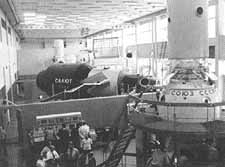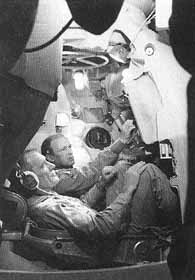
Developing Flight
Procedures
At the next meeting of all the Working Groups in April 1974, V. F. Bykovskiy joined Leonov and Kubasov as their instructor in developing flight procedures that would be practiced at the sessions scheduled for mid-summer in Star City and September in Houston. Their work began on the afternoon of 15 April, when the prime crews and Bob Overmyer spent an hour discussing the training that remained before the flight. Then after meeting briefly with the press on the morning of the 16th, they got down to work. Astronauts Bean and Evans worked with the Soviets in the command module simulator until lunch, and Overmeyer and the American prime crew spent that afternoon with them, evaluating docking procedures. The remaining eight work days were just as busy. Wednesday was spent with survival training and a review of the Russian-English glossary. On Thursday, the Soviets and Vance Brand received a briefing on the 16-millimeter movie [262] camera, after which they worked out in the gym. They went over the flight plan with the other astronauts and training personnel that afternoon. The entire team met for briefings on the docking module and trainer on Friday.
Nearly all the second week was devoted to learning to operate the docking module equipment during transfers, using the high fidelity mockup to verify the in-orbit transfer activities. They worked through the hundreds of necessary procedural instructions, like those required to establish the integrity of the seals and latches connecting the module to the spacecraft. Besides the 12 hours spent in the docking module trainer, the cosmonauts worked some more on the flight plan, practiced with the communications equipment, received an Apollo television camera briefing, and spent 3 hours in the command module simulator with Brand and Bean, working on the final stage of Apollo's rendezvous and approach to Soyuz.37 Stafford, speaking to the media on 26 April, said that the training session had been a "rewarding experience." In the case of crew transfers, considerable progress had been made. "For example," Stafford indicated, "the second day we tried it, we did it in about one-third the time that we did the first day." The reporters, it seemed, were also interested in the language question.
Bruce E. Hicks of United Press International asked Tom Stafford how the Americans were handling Russian. The general responded in Russian, and Leonov translated for him, replying that Stafford said that he understands the Soviet crew. Leonov added, "We've no problem in language." He went on to say that during the transfer training they had worked out the communication format that they planned to use during flight. "Our work is considerably better when the American crew speaks Russian and our crew speaks English," the Soviet commander said. "This forces us to maintain a considerable amount of discipline, to be attentive to each other, and to speak . . . much more clearly."38
Each of the subsequent meetings between the astronauts and cosmonauts stressed language exercises. At the 24 June to 11 July training session in Star City, every crewman received 10 hours of communications practice, which generally involved speaking over an intercom to a counterpart in a different office. Reading from a script, they could simulate the conversations that would pass between Apollo and Soyuz. This experience not only gave them an opportunity to improve their pronunciation but also introduced Leonov and Kubasov to Russian spoken with a Weatherford, Oklahoma, accent. "Soyuz, ehto Apollon. Stuikovka na pyat minut. . . ." This is what Stafford might say as his spacecraft closed the gap between the two ships. Leonov would reply, "Apollo, this is Soyuz. I understand; docking is in five minutes."
But there was time for some horseplay during that summer session in Russia. Ron Evans had brought half a suitcase of fireworks with him in....
 | |
|
[above] Testing and crew training constituted heavy workloads in ASTP during 1974. At left,Soviet and NASA engineers stand in front of a test chamber housing a Soyuz mockup during the March 1974 tests of the life support system at Star City. From left to right: V. V. Novikov, R. L. Grafe, D. F. Hughes, W. E. Elliss, R. E. Mayo, E. N. Harrin, W. W. Guy, the Soviet facility engineer, two test crewmen, and two military assistants to General V. N. Kholodkov (Soviet Academy of Sciences photo). The following month in Houston, crewmen Leonov and Slayton are in the docking module for checkout and familiarization training. | |
|
| |

|
In July 1974 the crews met in Star City for more training. At left, an overall view of spacecraft simulators at Star City, with Soyuz in the foreground and Salyut beyond. Below, N. N. Rukavishnikov (rear) explains Soyuz communications equipment to Deke Slayton. |
|
|
|
|
[below] In September 1974 in Houston, Soviet and American crewmen practice in the docking module mockup, rehearsing their conversation during a transfer operation. | |
 | |
[264] ...anticipation of the Fourth of July. After attending the American Ambassador's cocktail party, the Soviet and American crews returned to the astronauts' hotel at Star City. About dusk, Evans began the show, setting off a string of firecrackers. Stafford recalled that "it sounded like a machine gun and all the lights were going on in the building across the lake. Pretty soon you could see all these flashing lights. . . ." Once the police arrived, they formed a huddle. At this point, Stafford cried, "Hey, let's give them a bottle rocket!" With that, they fired a small rocket from a mineral water bottle, and it arced over the heads of the policemen. Finally one of the officers approached the Americans. Stafford called out in Russian, "Dobriy vecher. Kak vi pozhivaete.[*] . . . It is the day of our revolution," he explained. The official nodded that he understood the astronaut's explanation and retired with a look of amazement on his face.39
At the September exercises, the Americans had created a more elaborate simulation of inter-spacecraft communications. Working from a script prepared by the American crews and their language instructors, Leonov and Kubasov sat on one side of a glass-partitioned laboratory in the Flight Crew Training Facility at JSC and the Americans on the other side. This additional practice with flight conversations, coupled with further language training for both crews and more experience with hardware mockups, improved their ability to communicate with one another. As with all other aspects of preparing for the flight, learning Russian and English was an essential expenditure of long hours and hard concentration for both sides.40
37. NASA News Release, JSC, 74-64, "ASTP Working Groups to Meet at JSC," 10 Apr. 1974; Brzezinski, "ASTP Activity Planning Guide, April Cosmonaut Visit," 14-27 Apr. 1974; interview, Lonnie D. Cundieff-Ezell, 14 Aug. 1975; and "ASTP Teams Make progress on procedures for Joint Flight," Aviation Week & Space Technology, 6 May 1974. p. 18.
38. NASA Press Conference, JSC "ASTP Joint Crew Press Conference," 26 Apr. 1974.
39. Interview, Stafford-Ezell, 6 Apr. 1976; interview, Slayton-Ezell, 2 Mar. 1976; and interview, Anatole Forostenko-Ezell, 15 Mar. 1976.
40. NASA News Release,
JSC, 74-183, "ASTP Docking Test Near Completion," 2 Aug. 1974;
interview, Brzezinski-Ezell, 23 Sept. 1975; V. Sisnev, "SShA:
Sovmestnii kosmicheskii eksperiment; ikh budet pyatero" [USA: joint
experiment in space; there will be five of them], Trud, 1 Jan. 1975; and
"Start nazachen na 15 yulya" [The launch is scheduled for 15 July],
Trud, 1
Jan. 1975.
Next
